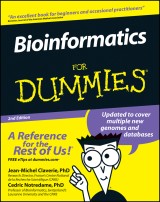Details

Bioinformatics For Dummies
2. Aufl.
|
22,99 € |
|
| Verlag: | Wiley |
| Format: | |
| Veröffentl.: | 12.03.2007 |
| ISBN/EAN: | 9780470121351 |
| Sprache: | englisch |
| Anzahl Seiten: | 464 |
DRM-geschütztes eBook, Sie benötigen z.B. Adobe Digital Editions und eine Adobe ID zum Lesen.
Beschreibungen
<p>Were you always curious about biology but were afraid to sit through long hours of dense reading? Did you like the subject when you were in high school but had other plans after you graduated? Now you can explore the human genome and analyze DNA without ever leaving your desktop!</p> <p><i>Bioinformatics For Dummies</i> is packed with valuable information that introduces you to this exciting new discipline. This easy-to-follow guide leads you step by step through every bioinformatics task that can be done over the Internet. Forget long equations, computer-geek gibberish, and installing bulky programs that slow down your computer. You’ll be amazed at all the things you can accomplish just by logging on and following these trusty directions. You get the tools you need to:</p> <ul> <li>Analyze all types of sequences</li> <li>Use all types of databases</li> <li>Work with DNA and protein sequences</li> <li>Conduct similarity searches</li> <li>Build a multiple sequence alignment</li> <li>Edit and publish alignments</li> <li>Visualize protein 3-D structures</li> <li>Construct phylogenetic trees</li> </ul> <p>This up-to-date second edition includes newly created and popular databases and Internet programs as well as multiple new genomes. It provides tips for using servers and places to seek resources to find out about what’s going on in the bioinformatics world. <i>Bioinformatics For Dummies</i> will show you how to get the most out of your PC and the right Web tools so you'll be searching databases and analyzing sequences like a pro!</p>
<b>Introduction.</b> <p><b>Part I: Getting Started in Bioinformatics.</b></p> <p>Chapter 1: Finding Out What Bioinformatics Can Do for You.</p> <p>Chapter 2: How Most People Use Bioinformatics.</p> <p><b>Part II: A Survival Guide to Bioinformatics.</b></p> <p>Chapter 3: Using Nucleotide Sequence Databases.</p> <p>Chapter 4: Using Protein and Specialized Sequence Databases.</p> <p>Chapter 5: Working with a Single DNA Sequence.</p> <p>Chapter 6: Working with a Single Protein Sequence.</p> <p><b>Part III: Becoming a Pro in Sequence Analysis.</b></p> <p>Chapter 7: Similarity Searches on Sequence Databases.</p> <p>Chapter 8: Comparing Two Sequences.</p> <p>Chapter 9: Building a Multiple Sequence Alignment.</p> <p>Chapter 10: Editing and Publishing Alignments.</p> <p><b>Part IV: Becoming a Specialist: Advanced Bioinformatics Techniques.</b></p> <p>Chapter 11: Working with Protein 3-D Structures.</p> <p>Chapter 12: Working with RNA.</p> <p>Chapter 13: Building Phylogenetic Trees.</p> <p><b>Part V: The Part of Tens.</b></p> <p>Chapter 14: The Ten (Okay, Twelve) Commandments for Using Servers.</p> <p>Chapter 15: Some Useful Bioinformatics Resources.</p> <p><b>Index.</b></p>
<b>Jean-Michel Claverie</b> is Professor of Medical Bioinformatics at the School of Medicine of the Université de la Méditerranée, and a consultant in genomics and bioinformatics. He is the founder and current head of the Structural & Genomic Information Laboratory, located in Marseilles, a sunny city on the Mediterranean coast of France. Using science as a pretext to travel, Jean-Michel has held positions in Paris (France), Sherbrooke (PQ, Canada), the Salk Institute (La Jolla, CA), the Pasteur Institute (Paris), Incyte pharmaceutical (Palo Alto, CA); and the National Center for Biotechnology Information (Bethesda, MD). He has used computers in biology since the early days –– his Ph.D. work involved modeling biochemical reactions by programming an 8K Honeywell 516 computer right from the console switches! Although he has no clear recollection of it, he has been credited with introducing the French word “bioinformatique” in the late eighties, before involuntarily coining the catchy “bioinformatics” by mistranslating it while giving a talk in English!<br /> Jean-Michel’s current research interests are in microbial and structural genomics, and in the development of bioinformatic methods for the prediction of gene function. He is the author or coauthor of more than 150 scientific publications, and a member of numerous international review panels and scientific councils. In his spare time, he enjoys the relaxed pace of life in Marseilles, with his wife Chantal and their two sons, Nicholas and Raphael. <p><b>Cedric Notredame</b> is a researcher at the French National Centre for Scientific Research. Cedric has used and abused the facilities offered by science to wander around Europe. After a Ph.D. at EMBL (Heidelberg, Germany) and at the European Bioinformatics Institute (Cambridge, UK) under the supervision of Des Higgins (yes, the ClustalW guy), Cedric did a post-doc at the National Institute of Medical Research (London, UK), in the lab of Willie Taylor and under the supervision of Jaap Heringa. He then did a post-doc in Lausanne (Switzerland) with Phillip Bucher, and remained involved with the Swiss Institute of Bioinformatics for several years. Having had his share of rain, snow, and wind, Cedric has finally settled in Marseilles, where the sun and the sea are simply warmer than any other place he has lived in.<br /> Cedric dedicates most of his research to the multiple sequence alignment problem and its many applications in biology. His friends claim that his entire life (past, present, future) is somehow stuffed into the T-Coffee multiple-sequence alignment package. When he is not busy dismantling T-Coffee and brewing new sequences, Cedric enjoys life in the company of his wife, Marita.</p>
<b>Search databases and analyze sequences like a pro</b> <p><b>Get the most out of your PC and the Web with the right tools</b></p> <p>Explore the human genome and analyze DNA — without leaving your desktop! All it takes is the basics of molecular biology and the wealth of information in this friendly guide. You'll discover the online tools and useful tips you need to ask the right questions, analyze sequences, and compare results. It's a plain-English introduction to the field!</p> <p><b>Discover how to</b></p> <ul> <li>Do biological research online</li> <li>Use gene-centric databases</li> <li>Visualize proteins in 3-D</li> <li>Interpret and analyze sequences</li> <li>Produce and publish results</li> </ul>


















